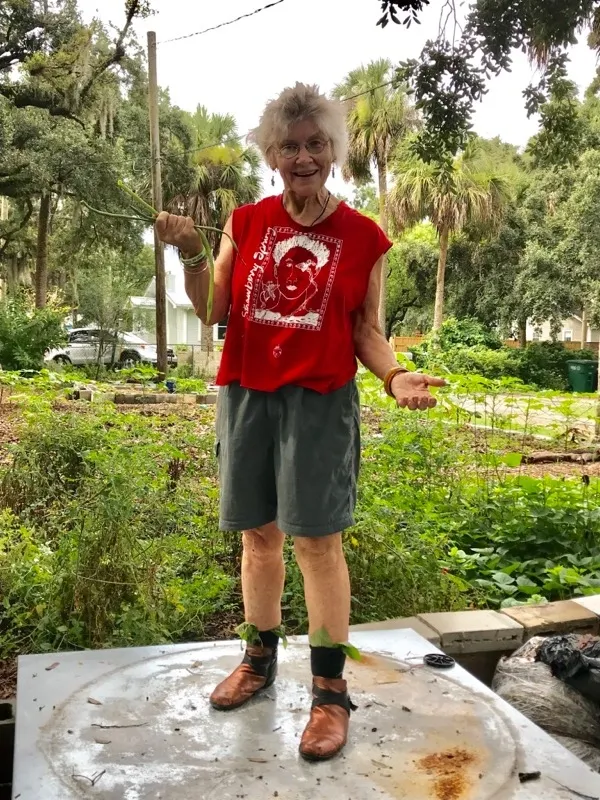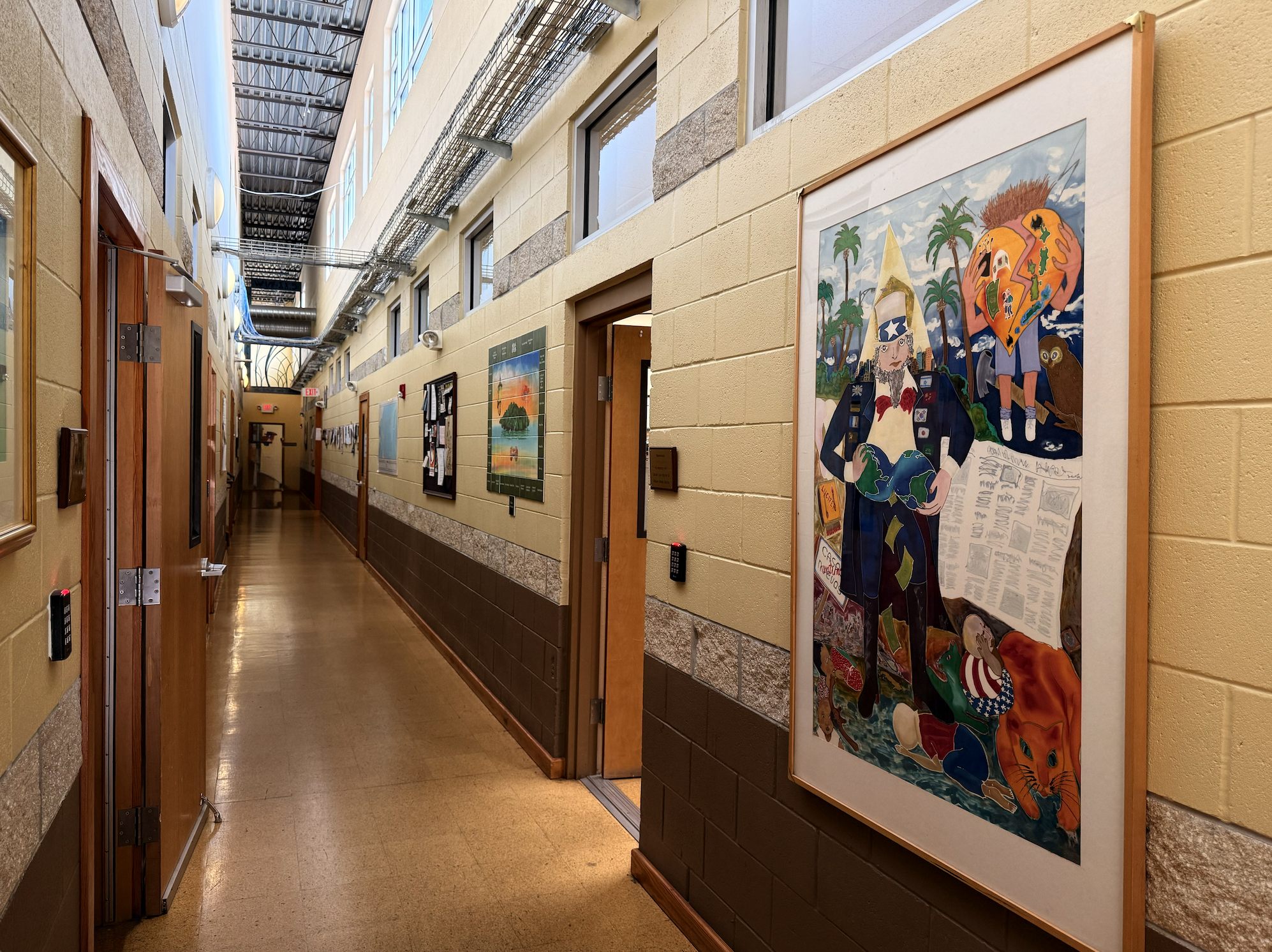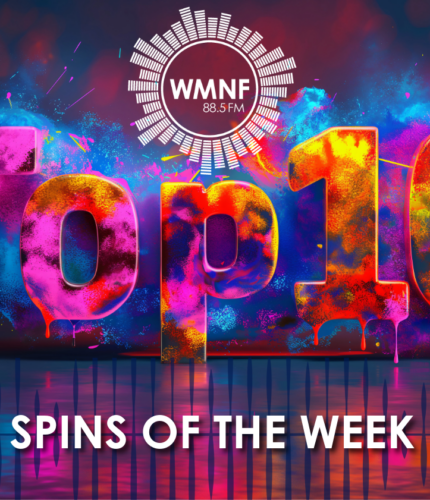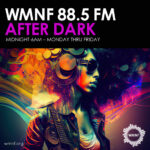
Every piece of art tells a story—but some, like this one, practically demand to be unraveled. This isn’t just a blog. It’s an open invitation to join me on a little adventure—to interpret, uncover, and connect with one of the most powerful political paintings hanging in the halls of WMNF. From the moment I saw it, I knew there was more beneath the surface. And that curiosity? It led me straight to the artist—and into a story I didn’t expect.
Hi, I’m Toni Phan, your favorite Social Media Intern here at WMNF—and today, I’m bringing you along on a visual adventure.
A Conversation I’ll Never Forget

What makes this story even more special is that I had the rare privilege of sitting down with the artist herself. Elizabeth Mitchell was kind enough to spend over 30 minutes with me, walking through every inch of the painting. With the sweetest New Zealand accent and a laugh that feels like sunshine, she explained the piece with so much warmth and passion, I couldn’t help but hang on her every word.
It’s not every day you get to learn directly from the person who poured their heart and soul into a work of art. She didn’t just tell me what each symbol meant—she shared memories, history, loss, and hope, all layered into that shimmering silk.
Her work doesn’t whisper its messages—it sings, howls, and occasionally scolds. And this painting? It’s called “Uncle Pentagon.”
“He’s not Uncle Sam. He’s Uncle Pentagon,” Elizabeth told me. “It’s about how the Pentagon and the war machine have taken over the power from the people. It’s a fake Uncle Sam.”
A Silk Scream Against Empire
Elizabeth doesn’t tiptoe around the point. Uncle Pentagon is a visual takedown of war profiteering, imperialism, and the capitalist engine that feeds off global chaos. It’s a painting that dares to say what press briefings won’t.
The Figure: A Frankenstein version of Uncle Sam cradles the Earth—not out of love, but to wring cash from it. His coat is patched with flags—not just America’s, but others who profit from war. He’s the embodiment of the global arms bazaar.
Florida at the Top: Look closely near the top of the painting and you’ll see palm trees—Elizabeth’s subtle nod to Florida, the place she now calls home. It anchors the piece in her current reality, even as it addresses global issues.
Hear No Evil, See No Evil, Speak No Evil: Down in the bottom left corner, three small human-like figures sit side by side—one covering their eyes, one their ears, and one their mouth. You might miss them at first, but they’re Elizabeth’s symbolic take on the classic ‘see no evil, hear no evil, speak no evil’ proverb. Nearby, there’s a tiny TV box—and that changes everything. These figures are reacting to what they see on the screen. They aren’t just symbolic of silence—they’re watching, and choosing silence. Elizabeth wanted this to reflect how we, as a society, consume global pain from a distance and turn away. Don’t look. Don’t listen. Don’t speak. Just scroll. Just shop. Just chill. Ignorance as comfort—and complicity.
Torture Victim: At his feet lies a woman in El Salvador’s colors—red shirt, blue pants, and a white bag over her head. Elizabeth shared that this was based on real-life accounts where a bag of lime was tied over the heads of prisoners. Lime, a substance used to dissolve dead animals or balance acidic soil, is dangerous to breathe. It chokes, blinds, and burns. The woman is not just bound—she’s being tortured, gasping for air and desperate for escape. It’s not only physical—it’s psychological warfare, meant to extract confessions or information. “It’s torture,” Elizabeth said. “So wicked, what people do.”
Kurdish Baby: On the left, wrapped in cloth, lies a red bundle—a baby, buried by Kurdish families forced to flee. This moment is based on a real photo. But as Elizabeth clarified, it’s not about the Kurdish people themselves—it’s about the world’s silence in response. The baby, tucked in with the family’s finest remaining cloth, becomes a symbol of lives lost in the cold margins of conflict—and the global indifference that followed.
Lucifer Matches: A literal brand of matches, now a metaphor. The flame that ignites war. The spark of corruption. The fire we can’t seem to put out.
Casa Nueva / Mentiras: A promise scrawled in lies. “New house” turned into “mentiras”—lies. It’s a jab at the empty promises of foreign aid deals that displace more than they rebuild.

The Broken Heart: This is Elizabeth’s own. Inside it? Her paintbrushes, a tent from her art show days, dancing figures, and New Zealand’s silhouette. It’s her world. Her loves. Her losses. She holds it up like a warning: this is what the world does to those who feel too much.
Spotted Owl: Endangered, ignored. A symbol of how industry bulldozes nature—quietly, methodically, irreversibly.
Giant Orange Cat: In the midst of all the symbolism, a big fluffy orange cat sits calmly. Why? “Because I like big orange cats,” Elizabeth said with a laugh. It’s a soft, playful detail in a painting full of hard truths—offering a brief, personal breath amid the weight. around the point. Uncle Pentagon is a visual takedown of war profiteering, imperialism, and the capitalist engine that feeds off global chaos. It’s a painting that dares to say what press briefings won’t.
“All my life is in that heart,” she said. “And it’s broken by what I see happening out there.”
Silk, Steam, and Spilled Truths
Silk may seem delicate, but in Elizabeth’s hands, it’s defiance incarnate. I didn’t even realize Uncle Pentagon was painted on silk until I asked Miss Julie—and once I found out, I had to know how it was made.
Elizabeth told me this piece was created back in the early 1980s. It took about a week to complete, but not a single part of that process was simple. First, she stretched the silk over a wooden frame and began drawing her design by hand. But here’s the thing—once you draw a line on silk using resist, there’s no going back. No undo button. Every mark is a commitment.
Then came the dye. Unlike paint, dye seeps into the fabric and allows light to pass through, which is why the colors practically glow. Once painted, the silk was carefully bundled up and steamed for an hour—in a vintage 1906 medical instrument sterilizer left over from the heyday of Dr. Gavilla’s office in Ybor. After that, it had to be washed, dried, and ironed to set the final image.

Why WMNF?
“WMNF has always made space for truth-tellers,” Elizabeth told me. “That’s rare—and I wanted this painting to live somewhere that doesn’t look away.”

She donated Uncle Pentagon not to decorate, but to disrupt. To start conversations in break rooms and hallways. And now, here I am, writing about it because I couldn’t ignore it any longer.
Meet the Artist

Born in New Zealand and now based in Florida, Elizabeth has been creating protest art on silk for over four decades. For years, Elizabeth traveled the Florida art circuit, setting up tents, selling her work, and teaching silk painting from her home. Today, she creates under the name Elizabeth Mitchell Studio, where her art continues to spark conversation and connection—quietly working its way into hearts and minds. You can explore more of her powerful, thought-provoking work at elizabethmitchellstudio.com.
“People didn’t buy the political paintings,” she told me. “But I painted them anyway.”
Final Thoughts
I came into this project just wanting to learn more about the artwork on our walls. I didn’t expect to have a 30-minute heart-to-heart with a passionate artist or to walk away feeling like I’d just uncovered a hidden piece of history.
So next time you pass by a piece of art—at WMNF or anywhere else—take a moment. Look closer. Ask questions. You never know what stories are waiting just beneath the surface.
Thank you so much for reading and supporting this WMNF art series. It means the world to me to share these stories with you. I’m Toni Phan and I’ll be back soon with another hidden gem from our station.
Missed the last piece? Check out my previous article in this WMNF art series uncovering the mysterious portrait of jazz legend Charles Vann!
Leave a Reply










